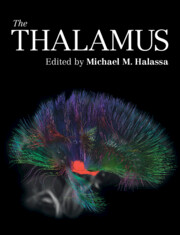Book contents
- The Thalamus
- The Thalamus
- Copyright page
- Contents
- Contributors
- Preface
- Section 1: History
- Section 2: Anatomy
- Section 3: Evolution
- Section 4: Development
- Section 5: Sensory Processing
- Section 6: Motor Control
- Chapter 14 Motor Thalamic Interactions with the Brainstem and Basal Ganglia
- Chapter 15 Cerebellar Regulation of the Thalamus
- Section 7: Cognition
- Section 8: Arousal
- Section 9: Computation
- Index
- References
Chapter 15 - Cerebellar Regulation of the Thalamus
from Section 6: - Motor Control
Published online by Cambridge University Press: 12 August 2022
- The Thalamus
- The Thalamus
- Copyright page
- Contents
- Contributors
- Preface
- Section 1: History
- Section 2: Anatomy
- Section 3: Evolution
- Section 4: Development
- Section 5: Sensory Processing
- Section 6: Motor Control
- Chapter 14 Motor Thalamic Interactions with the Brainstem and Basal Ganglia
- Chapter 15 Cerebellar Regulation of the Thalamus
- Section 7: Cognition
- Section 8: Arousal
- Section 9: Computation
- Index
- References
Summary
The motor thalamus is a complex system made of several subnuclei that together play a pivotal role in the planning and execution of movement. Some subnuclei were considered to form the “classical motor thalamus” (ventroanterior, ventrolateral, and ventromedial nuclei), and other thalamic subnuclei (centrolateral, parafascicular, and centromedian nuclei) innervate sensorimotor cortical areas. The cerebellum innervates all motor thalamus nuclei, with axons from all four different cerebellar nuclei. Decades of neuroanatomical tracer experiments have revealed that the cerebellar nuclei axons form excitatory synapses in the thalamus, thus creating somototopically organized cerebello-thalamo-cortical networks. Electrophysiological data at the synaptic, cellular, and network levels reveal how the action-potential firing patterns of cerebellar and cerebral cortical inputs are integrated in the motor thalamus to synergistically drive its output. In the current chapter, we provide a review of the anatomical and electrophysiological data and share our opinion on how the cerebellum regulates the precise timing of thalamo-cortical activity. We conclude our chapter with a discussion of the role of the cerebello-thalamo-cortical tract in the pathophysiology and treatment of movement disorders, autism spectrum disorders, and epilepsy.
- Type
- Chapter
- Information
- The Thalamus , pp. 284 - 306Publisher: Cambridge University PressPrint publication year: 2022

